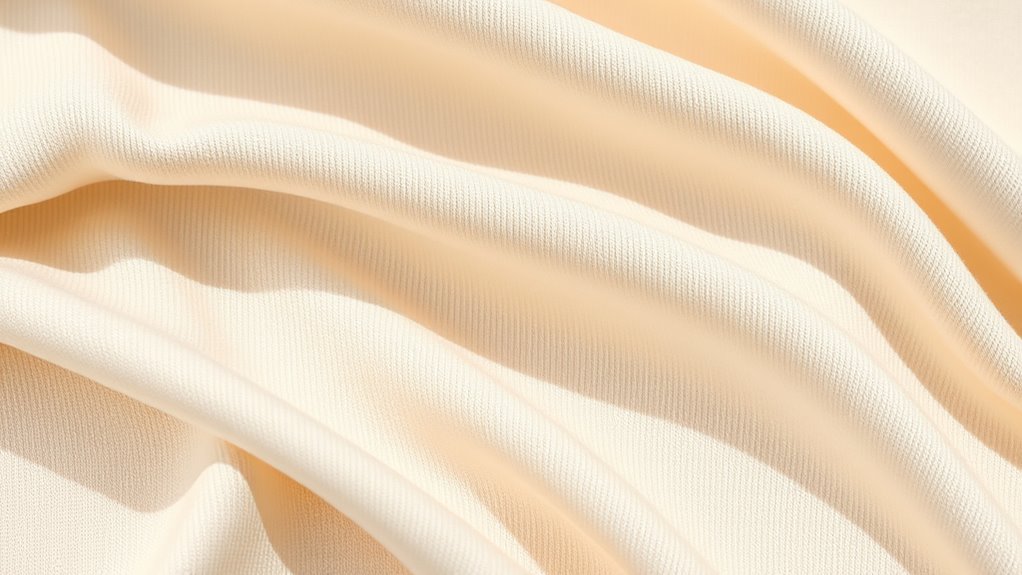Jersey knit is a versatile stretch fabric that offers softness, breathability, and flexibility, making it perfect for casual, active, and light formal wear. Its natural elasticity helps you create comfortable, form-fitting garments that retain their shape. To get the best out of this fabric, you should follow proper sewing techniques and care tips, like using stretch stitches and washing in cold water. Keep going, and you’ll discover even more ways to work with this adaptable fabric.
Key Takeaways
- Jersey knit fabric offers soft stretch, breathability, and smooth texture, making it ideal for casual, activewear, and light formal garments.
- Proper care, including cold wash and gentle drying, maintains jersey’s elasticity, softness, and appearance over time.
- Recognizing jersey’s stretch properties helps in selecting suitable patterns and ensuring comfortable, well-fitting garments.
- Use stretch or ballpoint needles and stretch stitches during sewing to prevent damage and ensure durable seams.
- Proper handling and finishing techniques extend garment lifespan, preserve shape, and keep jersey looking professional and fresh.

Jersey knit fabric is a popular choice for comfortable, versatile clothing, but understanding its qualities can help you make better choices for your projects. This fabric is known for its soft stretch, breathability, and smooth texture, making it ideal for casual wear, activewear, and even some light formal garments. To get the most out of your jersey fabric, you need to pay attention to fabric care and sewing techniques, ensuring your finished pieces look professional and last longer.
Jersey knit fabric offers comfort and versatility, perfect for casual, activewear, and light formal garments.
When it comes to fabric care, jersey knit requires gentle handling. Always wash it in cold water to prevent shrinking and color fading. Use a mild detergent and avoid bleach, which can damage the fibers and weaken the fabric. Opt for a gentle cycle to minimize stretching or deformation, especially if the fabric is delicate or has vibrant colors. After washing, lay your jersey items flat or hang them to dry—avoid wringing or twisting, as this can distort the fabric’s shape. If you prefer to use a dryer, select a low-heat setting and remove the garment promptly to avoid unnecessary shrinkage or pilling. Proper fabric care is essential to maintain the stretch and softness that make jersey knit so appealing. Additionally, understanding the stretch properties of jersey knit can help you select the right pattern and fit for your projects.
Sewing with jersey knit requires specific techniques to achieve clean, professional results. Because the fabric is stretchy, traditional sewing methods may cause puckering or skipped stitches. To prevent this, use a stretch or ballpoint needle, which glides between the fibers without damaging them. A stretch stitch or a narrow zigzag stitch allows the seams to stretch with the fabric, reducing the risk of tearing or popping. When cutting your pattern pieces, remember to add extra seam allowance if necessary, and be sure to cut on a stable surface to avoid stretching the fabric out of shape. When sewing, avoid pulling the fabric as you feed it through the machine; instead, guide it gently to maintain an even stitch line. Additionally, finishing the raw edges with a serger or zigzag stitch helps prevent fraying and extends the life of your garments.
Understanding these fabric care tips and sewing techniques will help you work more confidently with jersey knit. Its forgiving stretch and comfort make it a favorite for many projects, but treating it carefully ensures your finished pieces stay looking great and retain their shape over time. Whether you’re making T-shirts, dresses, or loungewear, respecting the fabric’s unique properties will result in better fits, longer-lasting garments, and a more enjoyable sewing experience.
Frequently Asked Questions
How Does Jersey Knit Compare to Other Stretch Fabrics Like Spandex or Lycra?
You’ll find that jersey knit is more breathable and softer than spandex or lycra, making it comfortable for everyday wear. While spandex and lycra offer excellent stretch and recovery, they’re less durable and less breathable. Jersey knit provides a good balance of fabric durability and stretch, making it versatile for various garments. Overall, it’s a great choice if you want comfort with decent durability and breathability.
Can Jersey Knit Be Used for Outdoor or Winter Clothing?
Yes, you can use jersey knit for outdoor or winter clothing, but keep in mind it offers limited thermal insulation and wind resistance on its own. To stay warm, layer jersey with insulating fabrics or add a wind-resistant outer layer. Its soft stretch makes it comfortable, but for colder conditions, consider thicker or thermal jersey options. Proper layering guarantees you stay cozy and protected during winter outdoor activities.
Is Jersey Knit Suitable for Beginner Sewing Projects?
Yes, jersey knit is great for beginner sewing projects because it’s stretchy, soft, and easy to handle. You’ll find it forgiving if you make mistakes, making your first projects like t-shirts or scarves more enjoyable. Just use a stretch stitch or zigzag to sew with jersey knit, and don’t forget to test your stitches first. It’s a perfect fabric to build your confidence in beginner sewing.
How Should I Care for Vintage or Delicate Jersey Knit Garments?
Like a true 21st-century fashion icon, you should hand wash delicate jerseys gently in cold water to keep them looking fresh. Avoid wringing or twisting the fabric, and lay them flat to dry, preventing any stretching or distortion. When storing vintage or delicate jersey knit garments, always store flat to retain their shape. This care routine guarantees your cherished pieces stay fabulous and timeless, just like a vintage vinyl record.
Are There Eco-Friendly or Organic Jersey Knit Options Available?
Yes, eco-friendly and organic jersey knit options are available. You can choose sustainable fiber options like organic cotton, Tencel, or hemp, which meet organic certification standards. These fabrics are grown without harmful chemicals, making them better for the environment and your skin. Look for certifications like GOTS or OEKO-TEX to guarantee the jersey knit you’re buying complies with strict sustainability and safety standards.
Conclusion
Now that you’ve explored jersey knit fabric, you might believe it’s just a simple stretch material. But in truth, its versatility and comfort prove otherwise—it’s like wearing a second skin that adapts to your every move. Imagine the confidence you’ll feel crafting or wearing garments made from this fabric, knowing you’re embracing both style and function. Jersey knit isn’t just fabric; it’s a secret weapon in your wardrobe that truly makes a difference.








